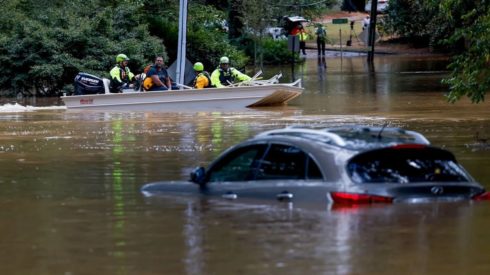Torrential rains from Storm Helene have unleashed catastrophic flooding across parts of North Carolina and Tennessee, marking the latest states in the southeastern U.S. to bear the brunt of this deadly disaster. Helene, which initially hit Florida as a hurricane—the strongest ever recorded in the state’s Big Bend region—has left a path of devastation as it moved northward. The death toll has now reached at least 63, with 10 fatalities reported in North Carolina alone. Thousands of residents remain stranded as more than 400 roads across the state are closed due to floodwaters.
In North Carolina, Asheville, a city known for its scenic mountains and vibrant arts scene, has been largely cut off by the flooding. The city, home to 94,000 residents, was eerily quiet on Saturday as emergency services scrambled to deliver supplies via airlift to affected communities. Governor Roy Cooper described Helene as “one of the worst storms in modern history” to hit the state, and rescue operations are ongoing to assist those trapped by rising waters. Federal emergency declarations have been issued in six states, including Florida and Georgia.
Widespread Power Outages and Infrastructure Collapse
Storm Helene’s impact has left over three million customers without power across five southeastern states. North Carolina has been hit particularly hard, with many areas still grappling with long queues at gas stations and widespread fuel shortages. The state’s infrastructure has been severely compromised, with more than 400 roads and bridges closed due to dangerous floodwaters. State officials are conducting daring rescues using boats, helicopters, and large vehicles to reach stranded residents, including a group of 50 workers and patients who were trapped on the roof of a flooded hospital in Tennessee.
In Tennessee, the situation in Erwin, where the Nolichucky River overflowed, has drawn significant attention. The fast-moving waters initially hampered rescue efforts, but helicopters from the Tennessee National Guard and Virginia State Police were eventually able to airlift the 58 stranded patients and staff to safety. With power outages, fuel shortages, and impassable roads, recovery efforts are expected to be prolonged. The financial toll of the storm is staggering, with damage estimates ranging between $95 billion and $110 billion.
Storm Helene Weakens, but Threats Persist
While Helene has weakened significantly after making landfall, weather experts continue to warn of ongoing dangers, including high winds, additional flooding, and even tornadoes. The storm’s remnants are still wreaking havoc as they move further inland. The National Weather Service has issued advisories across several states, cautioning residents to remain vigilant as floodwaters continue to rise. Despite the storm’s downgrade, it remains a significant threat, with isolated communities cut off and rescue operations ongoing.
Forecasters believe more storms could be on the horizon, as the Atlantic hurricane season does not officially end until November 30. The National Oceanic and Atmospheric Administration (NOAA) has already predicted a busy storm season, with as many as 25 named storms. Among these, eight to thirteen could become hurricanes, adding further strain to emergency management agencies already stretched thin by Helene’s devastation.
Federal Response and Long-Term Outlook
The federal government has mobilized to respond to the unprecedented crisis caused by Storm Helene. President Joe Biden, who described the storm’s aftermath as “overwhelming,” has directed FEMA to accelerate assistance efforts across the affected regions. Deanne Criswell, head of FEMA, has been tasked with ensuring additional rescue teams are deployed, especially to North Carolina, where resources are already stretched to their limits. Federal emergency declarations have also enabled affected states to access critical funding for recovery efforts.
As recovery efforts unfold, there is growing concern over the long-term impacts of Helene and the potential for further storms in the coming weeks. With the hurricane season far from over, experts caution that communities across the southeastern U.S. remain vulnerable. The devastation left behind by Helene will require extensive rebuilding, with many areas needing significant infrastructural improvements to prevent future disasters on this scale. Local governments, emergency response teams, and residents are bracing for a potentially long and difficult recovery.














